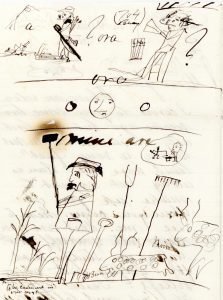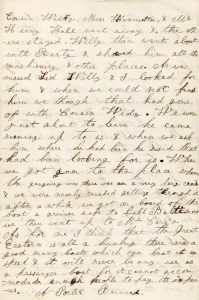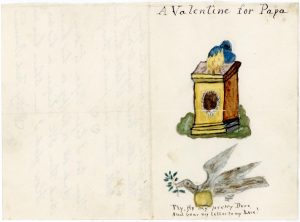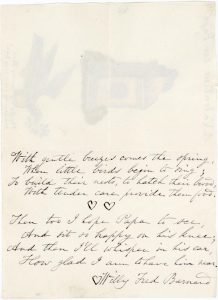
Processing collections according to updated archival standards gives RBML archivists the opportunity to discover anew our collections. In this post, Processing Archivist Celeste Brewer offers us insights into the practice of children writing letters during the Civil War-era. Historians typically foreground the writings and papers of “Great Men,” but as Celeste notes, paying attention to children’s words and ideas helps us see nuances in interpersonal relationships of the past.
With summer vacation here for most school-aged U.S. children, perhaps Willy Fred, Porter and John will inspire you to get your kids to put pen to paper instead of eyes-to-screen.
“We have bows and arrows and we shoot the pigs away from the gate,” seven-year-old Willy Fred Barnard announced to his father on October 4, 1854. This news opened the earliest in a group of letters written by children between 1854 and 1878, which can be found in the Rare Book and Manuscript Library’s newly processed Barnard Family Papers collection.
William Frederick Barnard (1848-1863) and his older brother, Augustus Porter Barnard (1847-1911), wrote letters to their father, John Gross Barnard (1815-1882) as soon as they were able. These letters are unusual for several reasons. First, that they exist at all; the Barnard children came from a wealthy family that valued education highly. (Their uncle, Frederick A. P. Barnard, would become president of Columbia College in 1864.) Willy Fred and Porter were privileged to be educated by private tutors from approximately the age of six.

Even the minority of young children living in the mid-nineteenth century who could both read and write—and had access to writing tools more permanent than a piece of chalk and a slate—had little reason to write letters to their parents until they were old enough to go away to school. However, Willy Fred and Porter’s father was an officer in the U.S. Army Corps of Engineers. Their mother had died in 1853. The boys lived in rural Maryland with their aunt and uncle, Sophia and William F. Brand.
William and Sophia clearly encouraged their nephews’ letter writing. Their annotations sometimes appear in the margins of the letters, and they often elaborated on topics the boys wrote about in their own letters to John. In addition to maintaining their relationships with their father, the boys’ letters demonstrated to him that they were safe and well, and their educations were progressing. They appear regularly in their father’s correspondence through the remainder of the 1850s.
The letters offer a firsthand glimpse at the lives of wealthy American boys, written in their own words, sometimes at length. Porter and Willy Fred’s schooling calendar left them with plenty of opportunities for recreation. They built a wagon, went swimming, planted vegetable gardens, and even tamed an opossum. They shared their father’s interest in engineering, or at least understood that he liked to discuss it. Their letters frequently mimic John’s habit of explaining how tools and mechanical systems were constructed.

The most detailed letters date from 1860. They describe an excursion to see Isambard Kingdom Brunel’s S.S. Great Eastern, which was then the largest ship in the world, at anchor in the Chesapeake Bay. This much-anticipated journey required travel by wagon, rail, and steamship. Twelve- and thirteen-year-old Willy Fred and Porter devoted pages to describing the ship’s features in detail. However, the boys ultimately decided that they were not impressed. The ship was not as big as they had expected, it was dirty, and the sandwiches sold on board were too expensive. “I think the Great Eastern is all a humbug,” Porter declared.

John Hall Barnard did write letters to his parents when he was a teenager enrolled in the U.S. Naval Academy. He corresponded with friends, too, including a boy named Sanford Curtis who lived in Watertown, Connecticut. San filled his letters to Jack with doodles. Their text is lively and jocular, without straying too far from the bounds of politeness. “Give my best regards to your mother and father and remembrances to the rest of the family,” he closed one letter, after complaining, “Our house is full of company all the time and it is the confoundedest bother in the world to have to keep dres’t [dressed] all the time.”

The Barnard children’s letters have value beyond the academic context as well. They are emotionally powerful documents that require relatively minimal historical knowledge to resonate. While they are distinctly of a different era, they are also immediately familiar to anyone who has ever set foot inside of a school. Their sweetness is tempered by the evident intensity with which Porter and Willy Fred miss their father and seek his approval. Knowing that Willy Fred, the most talented letter writer of his siblings, would die in the summer of 1863 at age fifteen, adds another somber note.
These compelling qualities draw readers from a variety of backgrounds to engage with the landscape of the past. The Barnard children’s letters reminds us that scholarly credentials are not a prerequisite for finding meaning in historical documents. While the past may be a foreign country, its inhabitants are still human, and they have much in common with us.
For more writing that reconsiders the archival record through processing, see Celeste’s other posts.

